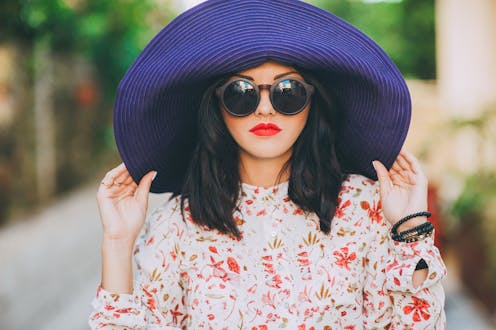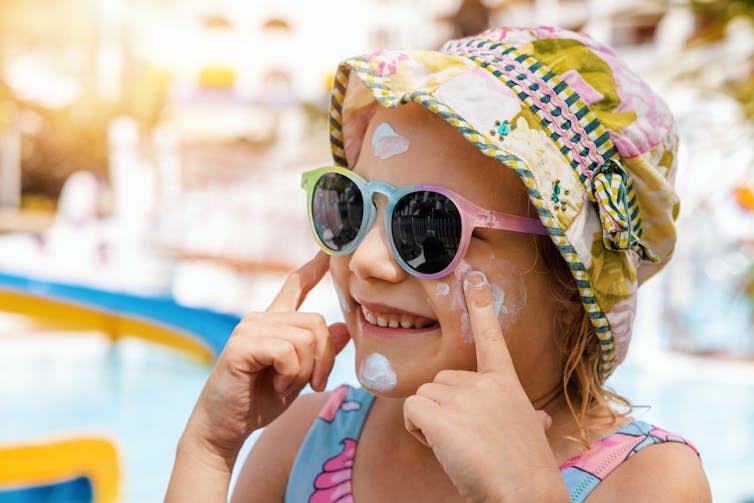
Australians are exposed to some of the highest levels of solar ultraviolet (UV) radiation in the world.
While we tend to focus on avoiding UV damage to our skin, it’s important to remember our eyes as well.
Last summer, only six in ten Australians who spent time outside during peak UV exposure times said they wore sunglasses.
But sunglasses are much more than a fashion statement. Here’s why they’re important for our eye health (and our skin) – and some tips on how to choose a pair that works.
What is UV radiation?
UV radiation is a type of energy produced by sources like the sun. There are three types: UVA, UVB, UVC. UVA and UVB are responsible for the sun-related damage to our skin and eyes.
UV can be direct, scattered or reflected, bouncing off surfaces such as water, sand and snow. But unlike the other types of energy the sun makes (visible light and infrared radiation), we can’t see or feel UV radiation.
This is why we can’t rely on clear skies or hot temperatures to work out if UV levels are high.
Instead, we use the UV Index, a scale from low (1–2) to extreme (11+).
Official guidelines recommend sun protection when the UV index is 3 or higher. This includes protecting our eyes.
How does UV light affect our eyes?
Excessive UV radiation can have both short and long-term effects on our eyes and surrounding skin.
In the short term, you might become sensitive to light or develop photokeratitis, sometimes known as “snow blindness”.
Photokeratitis is like a sunburn to the cornea (the clear, dome-shaped part at the front of the eye that lets light in) and makes the eyes sore, red and sensitive to light. Photokeratitis usually resolves with rest from light and eyedrops.
But the long-term effects of chronic UV exposure can be more severe.
It can lead to a fleshy growth on the eye called a pterygium, also known as “surfer’s eye”. This growth can obstruct vision if it grows over the cornea, requiring surgical removal.
Excessive UV exposure can also speed up the development of cataracts (where the lens inside the eye becomes cloudy and blurs the vision) or lead to skin cancers on the eye and eyelid.
Excessive UV exposure can be particularly harmful to children as the lens in their eyes aren’t able to filter UV light as well as adults – so it’s important for children to wear sunglasses too.
What about the skin?
UV radiation can also accelerate skin ageing.
It breaks down proteins in the skin which keep it elastic, such as elastin and collagen, and can trigger low-grade inflammation.
Without sunglasses, we also tend to squint more to try and reduce the amount of light entering our eyes. These repeated movements can contribute to the development of wrinkles and “crow’s feet” around the eyes.
What sunglasses should I choose?
In Australia and New Zealand, every pair of spectacles with tinted lenses must be be labelled to show the category of protection they offer. They are regulated by Australian/New Zealand Standards.
There are five categories for lenses:
categories 0–1 are “fashion spectacles”. They look like sunglasses but in fact offer little or no UV protection
category 2 provide a medium level of sun glare reduction and good UV protection
category 3 provide a high level of sun glare reduction and good UV protection
category 4 lenses are very dark and only recommended for use in extreme levels of glare, such as mountaineering, or at sea. These lenses are too dark to be used for driving.

What else should I know?
Good sunglasses don’t have to be expensive. The category of protection is more important than the price tag – so always check the label to see how well they block UV radiation.
Sunglasses that fit close to eyes, with good wrap around the face, provide the best protection in reducing both direct and reflected UV radiation.
Lenses can also be polarised, blocking any light waves coming from a horizontal direction. This reduces glare from reflective surfaces while increasing contrast – especially useful for water activities such as fishing.
Some sunglasses may also use the term “eye protection factor” (EPF). The EPF rating is based on how well a pair of sunglasses can protect your eyes from UVA and UVB based on the lenses and frame design. Look for an EPF of 9 or 10.
The label “UV400” is also useful, as it means the lenses block almost 100% of UV.
Protecting your eyes year round
Sunlight can also be beneficial to our eyes.
For example, morning sunlight can help us reset our body clocks and promote proper eye development in children to prevent shortsightedness. It is also important for the body’s production of vitamin D.
But moderation is key. The safest way to get the benefits of sunlight during summer is a few minutes of mid-morning or mid-afternoon sunlight. In late autumn and winter when the UV index is below 3, spending time outdoors during midday is beneficial.
As we’re exposed to UV radiation all year round, sunglasses are a good idea in any season. In summer, wearing a wide-brimmed hat and sunscreen, and limiting outdoor time during peak UV exposure, will also help protect your eyes and skin.
Flora Hui does not work for, consult, own shares in or receive funding from any company or organisation that would benefit from this article, and has disclosed no relevant affiliations beyond their academic appointment.
This article was originally published on The Conversation. Read the original article.







